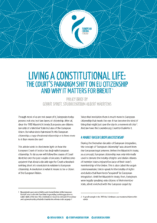Living a Constitutional Life: The Court’s Paradigm Shift on EU Citizenship and why it matters for Brexit
Author: Gerrit Spriet Supported by Studiecentrum Albert Maertens Year: 2018 Though most of us are not aware of it, Europeans today possess not one, but two layers of citizenship. After all, since the 1992 Maastricht treaty, Europeans are citizens not only of a Member State but also of the European Union. But what does that mean? Is this European citizenship a […]
